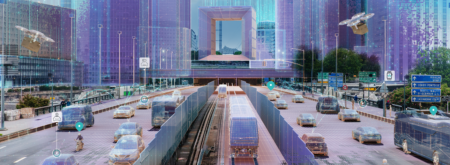Mitsubishi Electric Corporation has announced that it has developed technologies for automated mapping and extraction of transitions in mapping landscapes based on artificial intelligence (AI) and the company’s own Mobile Mapping System (MMS) for highly precise three-dimensional (3D) maps for autonomous driving applications.
As a forerunner in the industry, Mitsubishi Electric aims to contribute to the early implementation of maps that offer constantly updated dynamic information, such as traffic signals and information about surrounding vehicles and objects, which are indispensable for safe, highly precise autonomous driving. Both technologies will be exhibited for the first time at the CeBIT 2017 show in Hannover, Germany, which takes places on March 20-24. The automated mapping technology uses AI to quickly create precise, accurate 3D maps. Only necessary information, such as road markings and traffic signs, is extracted from laser-point clouds and camera data measured and collected by the MMS.
Mitsubishi’s MMS provides 3D positional information of roads and roadside structures with an absolute precision within 4in (10cm) or less, which is collected via a system consisting of laser scanners, cameras and GPS antennas, while driving. AI improves the precision of extraction and recognition of the only data necessary, resulting in 10 times faster map creation compared with industry-standard manual creation. The system also costs less than conventional methods.
Mitsubishi is using its difference extraction technology for earlier establishment of the dynamic map itself, and more efficient updating and maintenance at a faster pace. By automatically extracting characteristic points of past data and the latest laser-point cloud data measured with MMS, the difference extraction technology is able to distinguish differences and changes where characteristic points do not match. Due to this technology, the maintenance of dynamic maps and the updating of precise 3D maps can be accomplished much faster by automatic extraction of only the points that have changed, compared with updating the entire map each time.
Looking ahead, Mitsubishi plans to sell software using these automated mapping and difference extraction technologies to map publishers, including the Dynamic Map Planning Corporation, this coming October. The software will be used for the creation of highly precise 3D maps of expressways in Japan. Automated driving in Japan is expected to evolve from advanced driver assistance systems (ADAS) to automatic-driving level 3 (conditional autonomous operation) by 2020, creating further demand for related systems. Automatic driving systems will require combinations of in-vehicle sensors, as well as dynamic maps, of which the biggest challenges would be to keep the map information constantly up to date.
Mitsubishi’s new technologies for automated-mapping and extraction of transitions in mapping landscape create and renew precise 3D maps faster and more efficiently, and are therefore expected to serve as the core technologies of dynamic map creation in Japan. Going forward, the company will continue contributing toward the early creation, maintenance and updating of dynamic maps that will be indispensable for autonomous driving in its home country and overseas.




